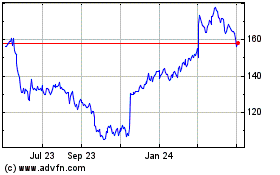By Sarah Nassauer
Holiday sales were sluggish at Target Corp., raising questions
about the strength of the retailer's turnaround plans and the
health of the U.S. consumer.
Target's sales rose 1.4% between Nov. 1 and Dec. 31 in stores
and through digital channels operating for at least 12 months, the
company said. It warned that growth for the full quarter, which
includes January, would likely come in less than half the 3% to 4%
growth it had predicted.
"We faced challenges throughout November and December in key
seasonal merchandise categories and our holiday sales did not meet
our expectations," Chief Executive Brian Cornell said.
Fresh government data -- the Census Bureau's report for December
retail sales expected Thursday -- will provide a better picture of
whether the shortfall reflects missteps at Target or evidence of a
broader pullback by U.S. consumers. Investors are also waiting to
hear from Walmart Inc., the country's biggest retailer, which is
slated to report results next month.
Market researcher NPD Group on Tuesday said holiday results were
lackluster, estimating that total sales rose 0.2% compared with the
previous year. The National Retail Federation is expected to
provide an update Thursday. The group had predicted more than 3%
growth in holiday sales, including in stores and online.
Target cited weak sales of toys and electronics, two categories
that are big sellers during the gift-giving season. The
Minneapolis-based chain also said Wednesday it was appointing a new
executive to oversee its fleet of roughly 1,800 stores.
Shares of Target fell 6.7% in Wednesday morning trading. The
shares nearly doubled last year and closed Tuesday at $125.26, near
all-time highs. While other traditional retailers reported
lackluster holiday results, Target had been held up as one of the
chains that adapted to shifting consumer habits by ramping up its
e-commerce operations and remodeling its stores.
Digital sales rose 19% in November and December compared with a
year ago, down from 31% growth in the third quarter. The company
has tried to drive such growth by offering free shipping on all
orders placed on its website during the holidays and rolling out a
variety of home-delivery and store-pickup services.
Sales at Target have been robust in recent quarters, aided by a
turnaround plan that included adding more in-house brands,
remodeling stores and cutting prices while spending more to grow
online and offer fast home delivery. Mr. Cornell announced the
turnaround plan in 2017 after reporting weak holiday sales that
season.
The company had boasted a streak of eight consecutive quarters
of at least 3% sales growth, including a 4.5% jump in the quarter
ended Nov. 3. In November, Mr. Cornell said the company was gaining
market share in the apparel, home and beauty categories. "We are
starting to see the bifurcation of winners and losers" in retail,
he told analysts a week before Black Friday.
Target said Wednesday it continued to post strong sales growth
in most of those categories, but they weren't enough to offset flat
toys sales and a 6% drop in electronics sales as well as weak sales
in some home categories.
The company is maintaining its profit targets, in part because
the categories with stronger sales earn high margins. For the
fourth quarter, Target expects adjusted earnings per share of $1.54
to $1.74 and full-year adjusted earnings per share of $6.25 to
$6.45.
Several other retailers have reported sluggish holiday sales
recently, but those have mostly included department stores and
specialty chains that entered the holiday season on weak footing.
Macy's Inc., J.C. Penney Co., Kohl's Corp. and Victoria's Secret
parent L Brands Inc. all reported lower sales in the critical
months of November and December.
Thus far Costco Wholesale Corp. is a lone bright spot, reporting
comparable sales up 9% in the five weeks ended Jan. 5, including
e-commerce and international sales.
The two biggest U.S. retailers, Walmart and Amazon.com Inc.,
haven't detailed their holiday results. Amazon said the day after
Christmas that it set a record for orders in the season and noted
strong demand for toys, fashion and electronics but didn't provide
sales data.
Overall, the strong U.S. economy, low unemployment and rising
wages boosted retail sales last year, government data show. But
much of the growth is coming from e-commerce, not store visits.
Online sales rose 18.8% from Nov. 1 through Christmas Eve, compared
with growth of 1.2% for in-store sales, according to Mastercard
SpendingPulse.
Target also said its chief stores officer, Janna Potts, 52 years
old, will retire and be succeeded immediately by another company
veteran, Mark Schindele, 50.
Ms. Potts, a 30-year Target employee, took over as stores chief
in January 2016. She will stay in an advisory role until May 1.
Mr. Schindele, who has worked at the company for nearly 20
years, was most recently responsible for remodeling stores and
rolling out smaller-format stores in urban areas.
The company also promoted two executives to permanently fill the
role vacated in early November when Mark Tritton resigned as chief
merchant to take over as CEO of Bed Bath & Beyond Inc.
Christina Hennington and Jill Sando will serve as chief
merchandising officers.
Write to Sarah Nassauer at sarah.nassauer@wsj.com
(END) Dow Jones Newswires
January 15, 2020 11:12 ET (16:12 GMT)
Copyright (c) 2020 Dow Jones & Company, Inc.
Target (NYSE:TGT)
Historical Stock Chart
From Mar 2024 to Apr 2024

Target (NYSE:TGT)
Historical Stock Chart
From Apr 2023 to Apr 2024
